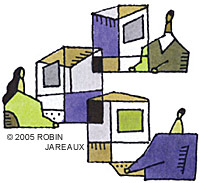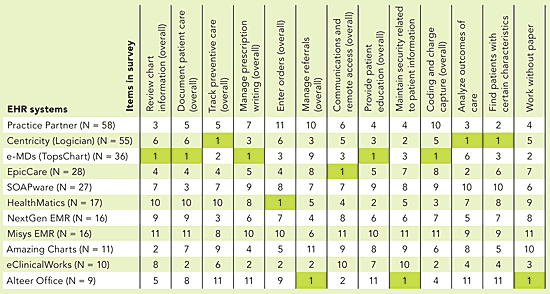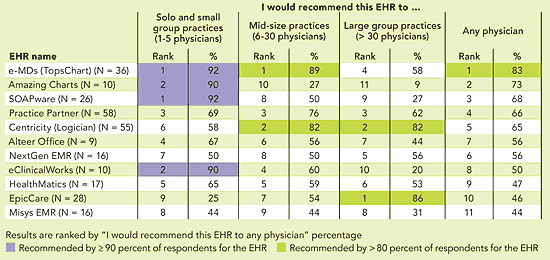
Contemplating the purchase of an EHR? Results of our informal survey may help.
Fam Pract Manag. 2005;12(9):29-35

Deciding whether to move to an electronic health record (EHR) system and which system to choose can be paralyzingly difficult questions. We hope this article can help. In the February 2005 issue of Family Practice Management, we published a survey instrument designed to elicit advice from family physicians already using EHR systems,1 and over the past several months we have collected more than 400 usable responses. The results offer help with both questions.
Because respondents were self-selected, the results of the survey do not necessarily reflect the state of EHR use in family medicine, but for physicians contemplating the purchase of an EHR, they may be even more useful. The results constitute the kind of advice you would get if you could ask 408 colleagues how they feel about the EHR systems they use.
About the respondents
The EHR marketplace is notoriously fragmented, with many small vendors in competition and few clear market leaders. Our results are certainly consistent with that picture. The 408 respondents reported on 77 different EHR systems, nine of which are noncommercial systems developed mostly for particular institutions – clinics, universities, the military, the Department of Veterans Affairs, etc. Of the 77 systems, 56 are used by no more than three respondents each. On the other hand, the 11 most commonly reported systems, each reported by nine more respondents, account for over two thirds of responses (69 percent; N = 283). In the analysis below, we report system-by-system results for these 11 systems, using data from all 408 respondents as a point of reference against which to view the individual-system results. We chose to report on these 11 systems because they offer enough responses to ensure a reasonable spread of opinions where respondents’ opinions differed. (For more on these 11 systems, see “EHR systems reported on in this article.”)
Respondents to the survey are generally pleased with the EHR systems they use. Whether they thought the system they use was a bad choice or a good choice to begin with, 76 percent (312) now think it a good choice. The fact that 66 percent (269) either made the final choice of system or had significant input into the decision may mean that a majority of respondents want to believe they made good choices even if they didn’t, but it could also mean that the more input a physician has into the decision, the more likely he or she is to be happy with the outcome. In any case, only a minority of those who made the final decision think now that it was a bad one (see “Respondent attitudes and degree of involvement in choice of EHR system”).
The survey asked respondents to use a seven-point scale ranging from Novice to Expert to rate their expertise as computer users “in general, and not just in terms of this EHR system.” Responses were skewed strongly toward the high end of the scale, with 78 percent rating themselves as above average and only 22 percent average or below. The survey did not specify behaviors or capabilities corresponding to the seven levels expertise, so the reported levels should be taken as indications of the respondents’ confidence in their abilities rather than their actual abilities.
In addition to collecting limited information about respondents and their practices, the survey covered several topic areas, including these:
Functionality,
Overall ease of use and flexibility,
Ongoing service and support,
Cost,
Overall satisfaction.
EHR SYSTEMS REPORTED ON IN THIS ARTICLE
| Company, Web address and telephone | Estimated size of current user base* |
|---|---|
| Alteer Officehttp://www.alteer.com 949–789–0500 | 350 family physicians in 250 practices; 70 percent of users are solo physicians; the main company focus is now California |
| Amazing Chartshttp://www.amazingcharts.com 866–903–0821 | > 725 practices, perhaps one third of which are family medicine practices |
| Centricity (Logician)http://www.gehealthcare.com/usen/img_info_systems/centricity_clin_info/prodcts/emr.html 800–558–5120 | > 10,000 physicians, of which more than 30 percent are family physicians |
| eClinicalWorkshttp://www.eclinicalworks.com 866–888–MY–CW | 3,600 practices, of which 120–130 are family medicine practices |
| e–MDs (TopsChart)http://www.emds.com 888–344–9836 | 730 family medicine practices |
| EpicCarehttp://www.epiccare.com 608–271–9000 | 80 clients representing 2,400 sites and > 66,000 physicians; 51 of the clients (1,790 sites, > 47,200 physicians) fully operational |
| HealthMatics EMRhttp://www.a4healthsystems.com 888–672–3282 | 250 family medicine clients representing nearly 400 sites |
| Misys EMRhttp://www.misyshealthcare.com/Products/product+portfolio/misys+emr/index.htm 866–MISYS–US | 18,000 practices with 92,000 physicians; family medicine the largest specialty segment |
| NextGen EMRhttp://www.nextgen.com/pro_emr.asp 215–657–7010 | Approximately 200 family medicine practices |
| Practice Partnerhttp://www.pmsi.com 800–770–7674 | 450 family medicine practices |
| SOAPwarehttp://www.docs.com 800–455–SOAP | 7,000–8,000 sites; 1,922 family-physician users, more than from any other specialty |
Functionality
The functionality section of the survey contained 12 subsections eliciting user satisfaction with a variety of EHR functions. For instance, the first subsection asked about satisfaction with “the way your EHR allows you to perform the following chart review functions.” It went on to list eight separate functions such as “obtain and review lab results” and “review prior vital signs,” along with a summary item: “review chart information (overall).” Respondents were asked to rate each Very satisfied, Satisfied, Neutral, Dissatisfied or Very dissatisfied, or to check Function not installed or Function installed but not used.
“Functionality rankings for 11 EHR systems” shows how the 11 systems ranked in each of the subsections, with rankings determined by percentage of Satisfied and Very satisfied responses combined. As you will see, e-MDs (formerly TopsChart) was ranked first in five areas, while Centricity (formerly Logician) and Alteer Office received three first-place rankings each, and EpicCare and HealthMatics received one each. For a different perspective on responses in this realm, see “Overall satisfaction with functionality of 11 EHR systems.” For each of the 11 systems, the chart represents the percentage distribution of responses to the 13 items represented in the “Functionality rankings” table. Bars to the right of the center line represent responses of Satisfied and Very satisfied, while those to the left represent dissatisfaction and other responses. The results for all 408 respondents as a group are plotted separately for comparison. Both sides of the center line are important. For instance, e-MDs has the highest rating for overall satisfaction with functionality, followed by Centricity, eClinical-Works and EpicCare. But some of the systems toward the bottom of the chart have relatively low dissatisfaction scores despite their relatively low satisfaction scores. In the cases of Amazing Charts and SOAPware especially, this seems to be accounted for by large percentages of Function not installed responses. Such responses may of course reflect dissatisfaction with the EHR, but not necessarily.
A word about this chart format, which is used often in the article: By displaying the four “satisfaction/dissatisfaction” bars in characteristic colors and arranging them around the center line, the chart gives you a way to compare those ratings at a glance. And by including bars for other responses, it gives you a more complete picture of the data collected. The total length of each bar represents 100 percent of responses, with some slight variation because of rounding and a handful of blank responses. Just remember that the less colorful bars for Neutral, Function not installed, etc. are not necessarily measures of satisfaction or dissatisfaction; they could as easily be shown on the right as on the left of the “satisfaction/dissatisfaction” bars.
FUNCTIONALITY RANKINGS FOR 11 EHR SYSTEMS
Rankings are based on the combined percentages of Satisfied and Very satisfied responses to summary questions about functionality subcategories, except for “Maintain security related to patient information” and the three right-most columns, which are from subsections that did not include summary items. The highest rank for each item is highlighted.

Overall ease of use and flexibility
The survey included four items in this general area, asking the respondent to indicate his or her level of agreement or disagreement with these statements:
This EHR allows individual user-specific customization.
This EHR minimizes user data input.
This EHR offers multiple note creation options.
This EHR is fast (minimal wait between screens, minimal boot-up time, etc.).
Summarizing the results in one chart, as we did for overall satisfaction with functionality, produced the chart in “Overall ease-of-use ratings for 11 EHR systems.” The chart shows the percentage distribution of responses to the four items above. The higher the Agree and Strongly agree percentages, the more flexible and easy to use the system is considered by respondents. As you can see, e-MDs got the highest rating, with SOAPware, Amazing Charts, Practice Partner and Centricity following. The rest of the 11 systems all fell below the average for all responses, with Misys EMR bringing up the rear.
Given that the functionality of an EHR system is enhanced by the presence of software interfaces with related systems, the survey asked about interfaces with the practice management system (PMS), a laboratory system, a radiology system, a hospital information system and the information systems of commercial pharmacies. The PMS and lab interfaces are present in a majority of the EHR installations respondents reported on, and the average number of interfaces present varied from less than one with SOAPware and Amazing Charts to 3.7 with EpicCare.
Ongoing support
The survey asked respondents to indicate their agreement or disagreement with the statement, “Our EHR company provides excellent ongoing support and service.” Some 61 percent said they agreed or strongly agreed, although the distribution of responses varied a good deal from one system to the next in the 11 systems most commonly reported (see “Ongoing support and service”). The highest rated system in this category was Alteer Office, with e-MDs, Amazing Charts, SOAPware and eClinicalWorks following.
Cost and overall satisfaction
While the survey asked respondents to supply the estimated annual cost of the EHR per physician, 180 respondents left the field blank, and the wide range of costs given by those who did answer the question made the cost figures seem likely to be unreliable. For instance, respondents for Practice Partner gave estimates ranging from $2,000 to $250,000 per physician per year, and respondents for Amazing Charts gave estimates ranging from $60 to $10,000. We suspect that respondents varied in the costs they included, and some may not have known the actual costs, supplying guesses instead. If the data tell us anything about costs, it’s that SOAPware and Amazing Charts seem relatively inexpensive, with average reported costs of $1,000 to $2,000 per physician per year, while the rest have costs ranging upward from $9,000 per physician per year.
One cost-related item may well give more insight into the respondent’s subjective evaluation of the value of his or her EHR system than into the actual cost. We asked respondents to indicate agreement or disagreement with the statement, “This EHR cost more than it’s worth,” with the results shown in “Perceived value.” Given the format of the statement, greater percentages of disagreement with it imply a higher ratio of benefits to cost. Thus, Amazing Charts comes out on top in this analysis, with 100 percent of respondents (11) indicating that they do not agree that the system costs more than it’s worth. Misys EMR again falls to the bottom of the pile, with 50 percent of respondents (8) agreeing that the system cost more than it’s worth.
Another indicator of satisfaction, and a finding that is encouraging for EHR use in general, is that 87 percent of respondents disagreed or strongly disagreed with the statement, “If I could go back to paper-based records with no financial penalties, I would do so.” Generally speaking, they like their EHRs.
To get another perspective on satisfaction, the survey asked respondents to indicate their agreement or disagreement with statements recommending the EHR system they use to practices of three size ranges and to any physician. Ranking the systems separately for each of the four questions, with ranking based on the sum of Agree and Strongly agree percentages, yields the table shown in “Respondent recommendations.” Percentages are given alongside the rankings because percentage differences between systems with adjacent rankings were quite small in some cases. The top four systems for small practices formed a tight group ranging from 92 percent down to 90 percent: e-MDs, SOAPware, Amazing Charts and eClinical-Works. In the other categories, one or two systems stand out – e-MDs and Centricity for mid-size practices, Epic-Care and Centricity for large practices, and e-MDs for any physician.
RESPONDENT RECOMMENDATIONS

Proceed with caution
While we believe you will find the results of this survey useful in deciding whether to move to an EHR system and which system to select, we urge you to keep in mind several limitations. First, the small number of respondents for many EHR systems may mean that many potentially excellent systems aren’t evaluated adequately. Moreover, even for systems included in the 11 we analyzed, small cell sizes mean that even one additional response might have changed results considerably. To take an extreme example, consider that each of the nine respondents for Alteer Office accounts for roughly 11 percent of the results, and a 10th respondent could have moved the results by 10 percent. Finally, the fact that respondents were self-selected opens the possibility of selection bias. To repeat what we said at the outset, the best way to interpret the data is to regard it as advice you might get from 408 colleagues who volunteered to report on their experience with their EHR systems.
ADDITIONAL SURVEY RESULTS
To see more detailed information on respondents and their practices, the EHR systems they reported, and their overall satisfaction with EHRs, see “Appendix: Additional Survey Results,” which can be download below. Among other things, the appendix includes a chart showing the number of users reporting each of the 77 EHR systems mentioned, tables showing how many software interfaces are present in the reported EHR installations, and system-specific responses to the statement, “If I could go back to paper-based records with no financial penalties, I would do so.”